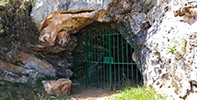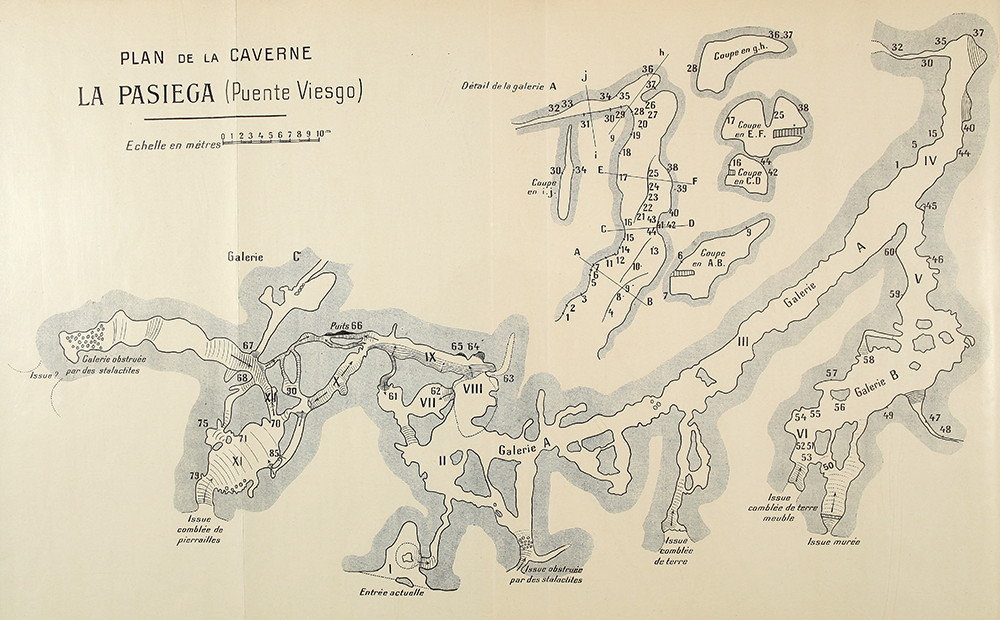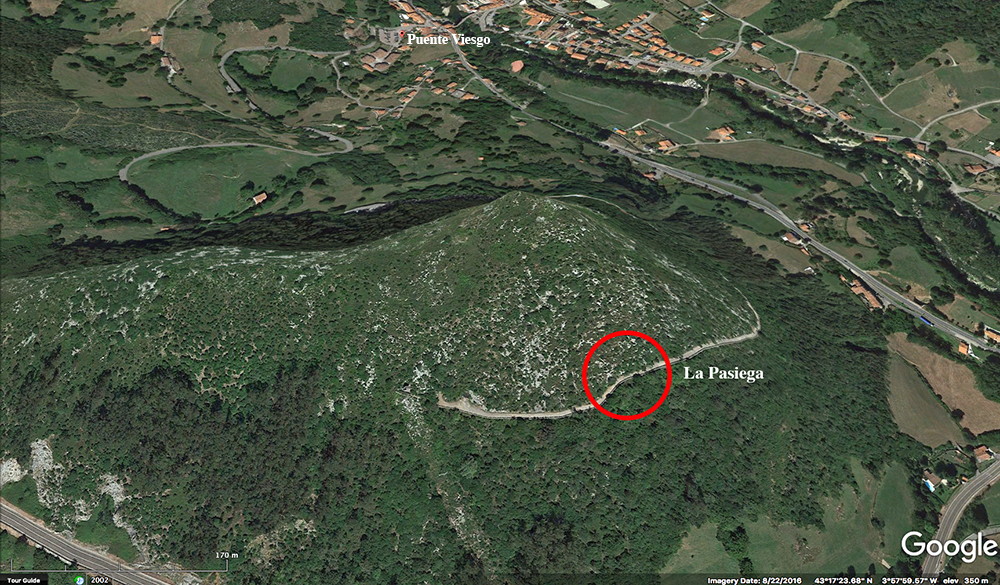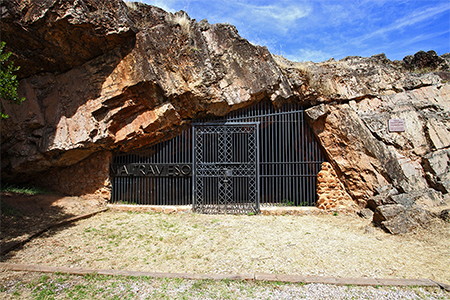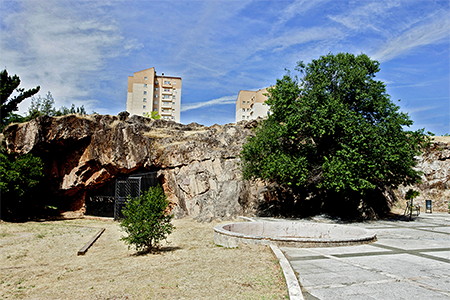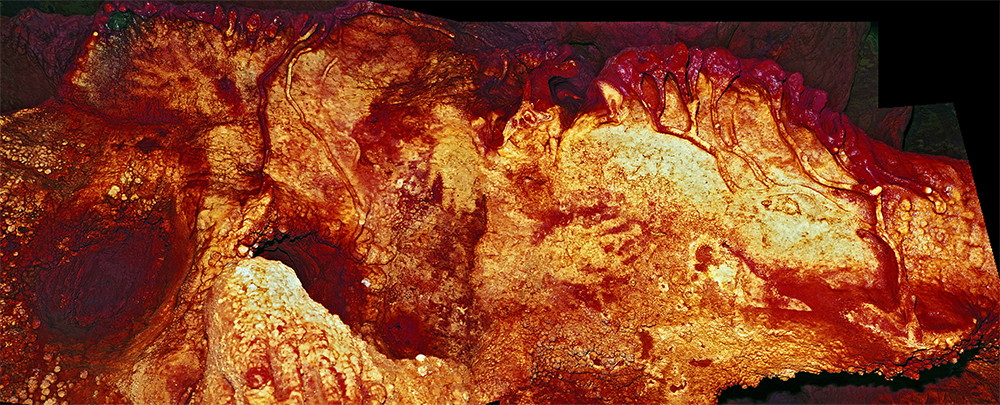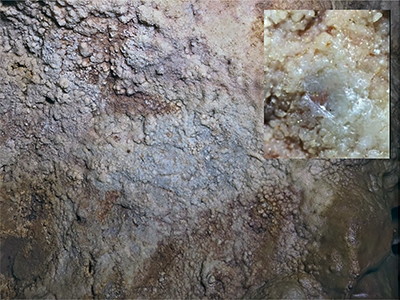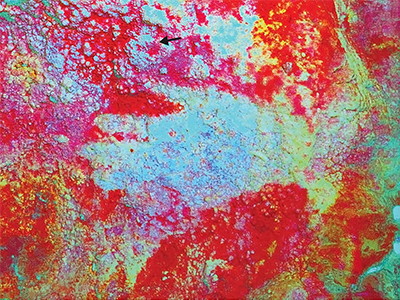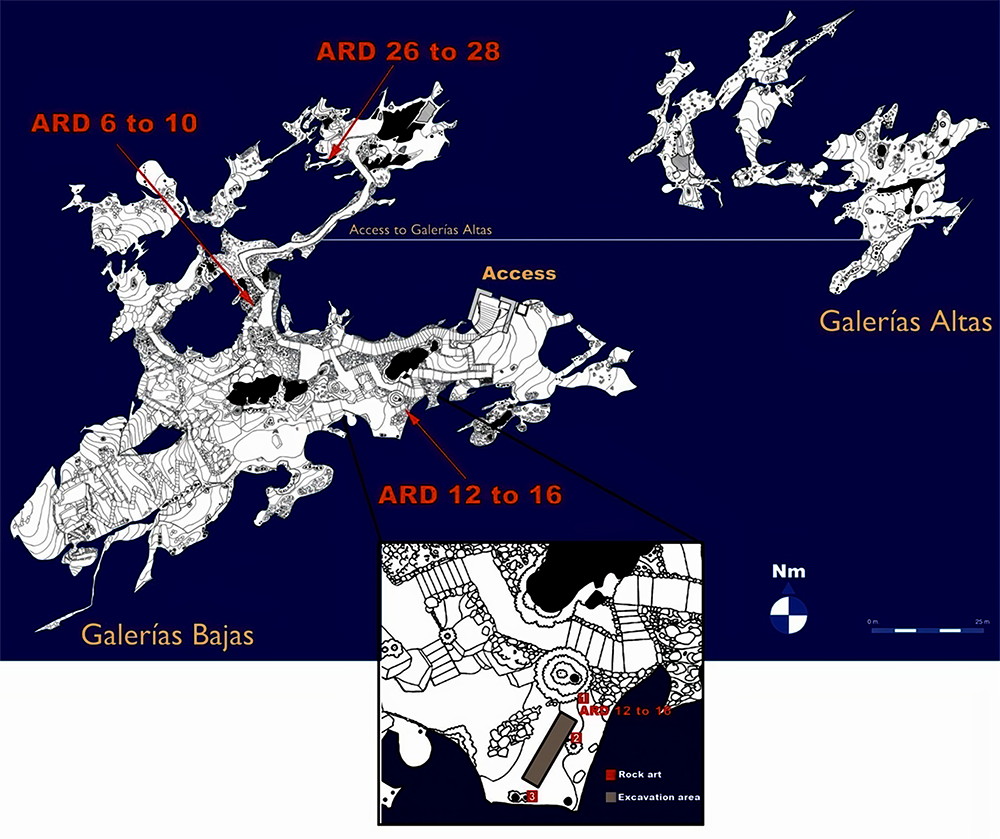Back to Don's Maps
 Back to Archaeological Sites
Back to Archaeological Sites
 Back to the review of hominins
Back to the review of hominins
Neanderthal Art
But it ain't necessarily so.
When Neanderthals were first described on the basis of skeletons found in the Neander Valley in Germany, they were presented as not quite human. 'Neanderthal' has since become an insult for someone who was lacking in intelligence and culture.
Steadily, evidence has grown that Neanderthals had most of the cultural abilities of anatomically modern humans. They had fire, they buried their dead, and used ochre as part of the burial ceremony, they drilled holes in seashells to create personal adornments, they created sophisticated flint tools.
What has been missing is evidence of their artistic ability, in particular art on the walls of caves, as is much in evidence for anatomically modern humans, such as those from the Magdalenian.
Hoffmann (2018) produced a paper that stated that a ladder shaped sign in the Pasiega Cave had been dated to a minimum age (64 800 BP).
This has now been shown to be false by some giants of the field, in a many authored refutation of this conclusion. See: White et al. (2019)
Text above: Don Hitchcock
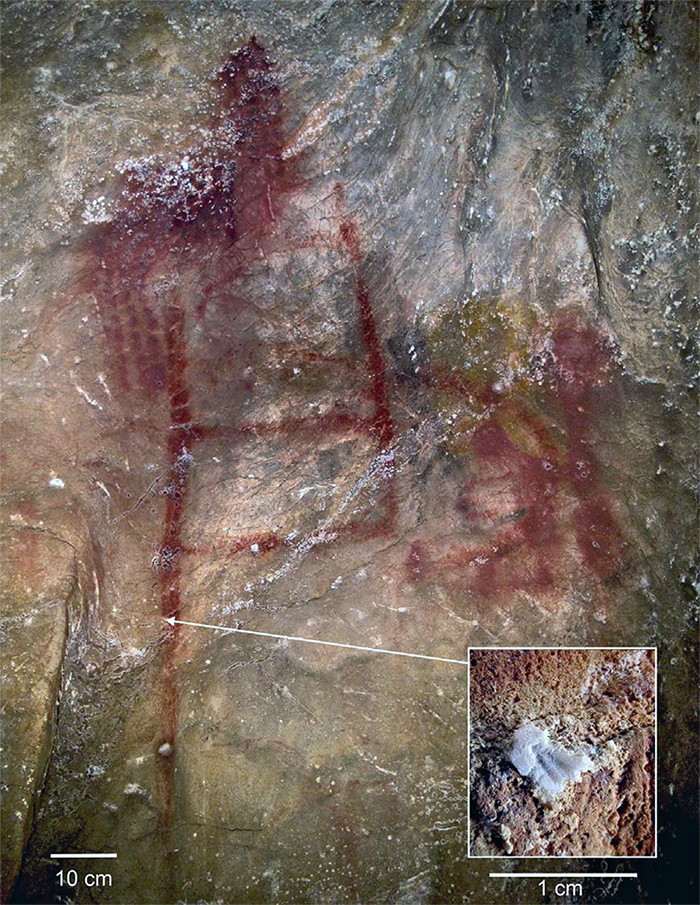
Red scalariform (ladder shaped) sign, panel 78 in hall XI of La Pasiega gallery C. This panel features the La Trampa pictorial group (21). (Inset) The authors contended that the crust had been sampled and analysed for a minimum age of (64 800 BP), which meant that the sign was older than this.
Photo: Hoffmann (2018)
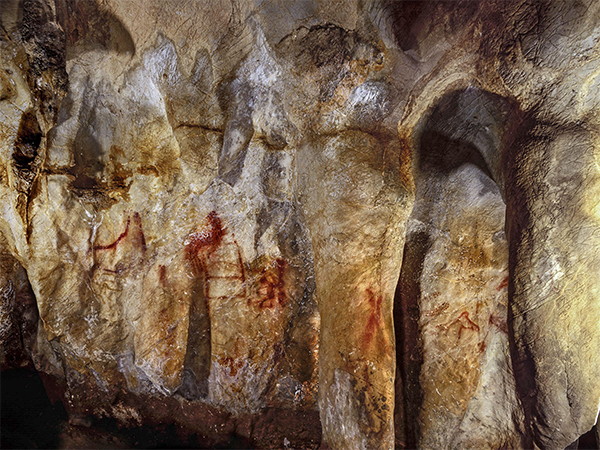
This excellent photo shows the scalariform sign in its local environment.
Photo: http://wksu.org/post/cave-art-may-have-been-handiwork-neanderthals
Plan of La Pasiega, 1913.
Photo: Breuil et al. (1913)
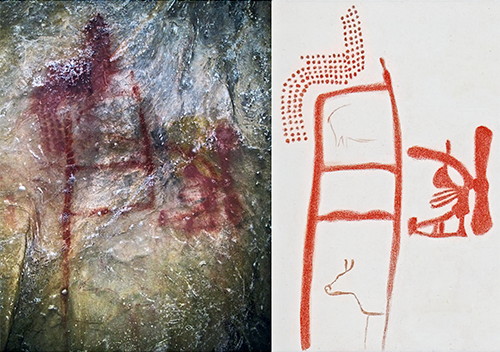
La Pasiega C, rectangular, scalariform motif with incomplete zoomorphs and red dots on Panel 78.
(left) Photo of the motif.
(right) Drawing by Breuil.
( note that only the ladder shaped image was thought to be by Neandertals - Don )
Photo and text: Hoffmann et al. (2018)
Early dates for 'Neanderthal cave art' may be wrong
Early doubt was cast on the dating for the Neanderthal Cave Art, as in the paper by Aubert, Brumm, Huntley (2018).
My thanks to Jillian A Huntley, one of the authors, for access to this paper, which was itself referenced in the 2019 review by White et al. (2019)
As the authors point out, 'The key condition is demonstrating an unambiguous stratigraphic relationship between the [dated carbonate] sample and the art whose age we wish to constrain' (Hoffmann et al. (2018)). However, establishing this relationship is not necessarily straightforward. In our opinion, it is possible that Hoffmann et al. (2018) unintentionally dated carbonate deposits that were a part of the rock face, or 'canvas', upon which the images were created, and which may be far older than the artworks.
At La Pasiega and Maltravieso, Hoffmann et al. (2018) did not cut a section through the carbonate deposits into the ‘canvas’, nor did they completely expose the underlying paint. Doing so would have allowed them to clearly observe the stratigraphic relationship between the layers of dated carbonate materials, the paints of the adjoining visible artworks, and the ‘canvas’. Instead, in each case the team scraped the carbonate deposit until they considered that it was changing color (Hoffmann et al. (2018)).
This was seen as indicating that they were coming close to the underlying paint of the artwork, and hence they stopped sampling at this point. The team then dated the sampled carbonate under the belief that it had formed on top of the paint layer corresponding to the nearby artwork, and thus could provide a minimum age for the art. But without directly exposing any part of the putative paint layer it is not possible to be certain that an apparent color change demonstrates that it is paint underneath the carbonate (Aubert 2017).
The color change noted during sampling might only be an indication of the proximity of ‘canvas’, not paint. Indeed, it is possible that, owing to differential weathering, the part of the ‘canvas’ covered over by carbonate deposits could be different in color to exposed areas of ‘canvas’, to the point where it could be mistaken for paint if not directly observed. Moreover, in our view, a color change is not evident from most images in the paper (Hoffmann et al. (2018)).
Now, White et al. (2019) have produced a paper which shows that the results were not as reliable as they at first appeared.
In the paper, White et al.(2019) make the following points:
Consequently, the authors claim Neanderthal authorship of the first parietal art in Europe. This proposition is alarming to many archaeologists due to the multiple sources of error inherent in this dating method, notably the leaching of Uranium resulting in an overestimation of sample ages. The possible overestimation of the U/Th dates is not discussed in Hoffmann et al. (2018). Instead they considered that a correct stratigraphy is enough to prove a closed system because 'it is highly unlikely that leaching of U or incorporation of Th would simultaneously affect all of its layers'.
The results presented by Hoffmann et al. (2018) are especially troubling since they contradict more than one hundred years of research observations on the Neanderthal and modern human archaeological record. The authors seem to abandon that whole body of archaeological knowledge and reasoning, instead placing all their trust in physicochemical measurements. This approach is puzzling given that certain of the coauthors have previously railed against 'the interpretative abuses derived from the uncritical application of 'hard science' analytical methods to the study of the Palaeolithic rock art phenomenon'. While absolute dating methods have certainly modified some of our ideas about the chronology of rock art in Europe, the application of these methods (including U-Th dating) is not without problems.
Hoffmann et al. (2018) retained only the date of 64.86 ka for La Pasiega, chosen from among 20 much more recent dates. No consideration is given to the possibility that this outlier date could be due to uranium leaching resulting from local hydrological conditions.
Hoffmann et al. (2018) have very little discussion of the archaeological data that contradict their results. This led us to undertake a review of the totality of available data, focusing in particular on rectangular signs and hand stencils. To avoid distraction, we leave aside the question of Neanderthal symbolic and cognitive capacities in favour of a close examination of archaeological and geophysical facts and observations. It goes without saying that if the ca. 65 ka date is spurious, the claim for Neanderthal authorship dissolves, exclusive of whether Neanderthals were capable or not of such behaviour.
( It should be noted that the authors include:
Randall White, Gerhard Bosinski, Raphaëlle Bourrillon, Jean Clottes, Margaret W. Conkey, Soledad Corchón Rodriguez, Miguel Cortés-Sánchez, Marco de la Rasilla Vives, Brigitte Delluc, Gilles Delluc, Valérie Feruglio, Harald Floss, Pascal Foucher, Carole Fritz, Oscar Fuentes, Diego Garate, Jesús González Gómez, Manuel R. González-Morales, María González-Pumariega Solis, Marc Groenen, Jacques Jaubert, María Aránzazu Martinez-Aguirre, María-Ángeles Medina Alcaide, Oscar Moro Abadia, Roberto Ontañón Peredo, Elena Paillet-Man-Estier, Patrick Paillet, Stéphane Petrognani, Romain Pigeaud, Geneviève Pinçon, Frédéric Plassard, Sergio Ripoll López, Olivia Rivero Vilá, Eric Robert, Aitor Ruiz-Redondo, Juan F. Ruiz López, Cristina San Juan-Foucher, José Luis Sanchidrián Torti, Georges Sauvet, María Dolores Simón-Vallejo, Gilles Tosello, Pilar Utrilla, Denis Vialou, and Mark D. Willis.
Once that lineup of distinguished scientists says that you are wrong, it is game over - Don )
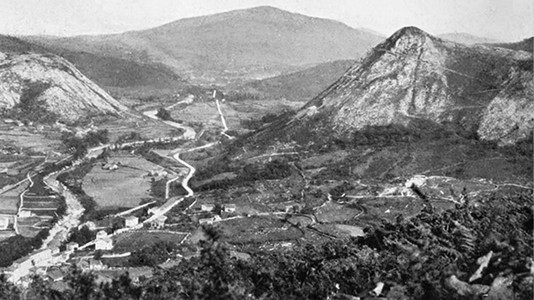
Valley of the Rio Pas at Puente Viesgo, Spain.
Over half way up the farther side of the prominent peak is the cave of La Pasiega and a little lower down on the side facing the river (within view) is the famous Castillo cave and grotto where man lived periodically almost from the earliest stone age down close to historic times.
Photo and text: Dickson (1915)
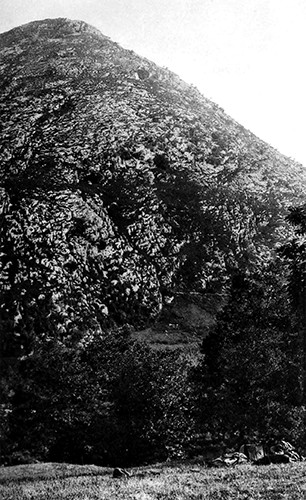
Plate I.
Outside La Pasiega.
The slope of Picacho, where the entrance to La Pasiega may be found.
Photo: Obermaier, in Breuil et al. (1913)
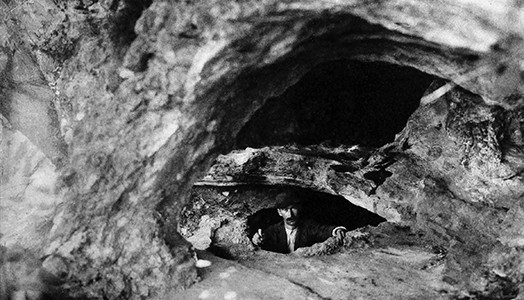
Plate I.
Entrance to La Pasiega circa 1911.
The man in this photograph is Alejandro Mena Garay, right hand man of Obermaier and chief of the Spanish digging workers. He holds a candle in his hand, emerging from the cave.
( My sincere thanks for this useful identification to Alejandro Mena Campuzano, his great grandson, p.c. - Don )
Photo: Obermaier, in Breuil et al. (1913)
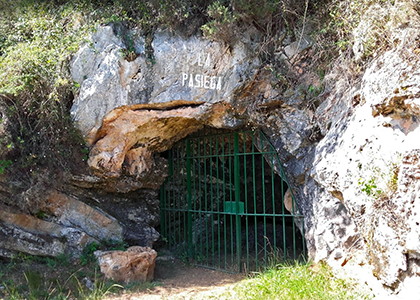
Entrance to La Pasiega in August 2016.
( comparison with the photograph above shows that the entrance has been enlarged to permit easier access, but not excessively so - Don )
Photo: © Carmen F.
Source: Google Maps
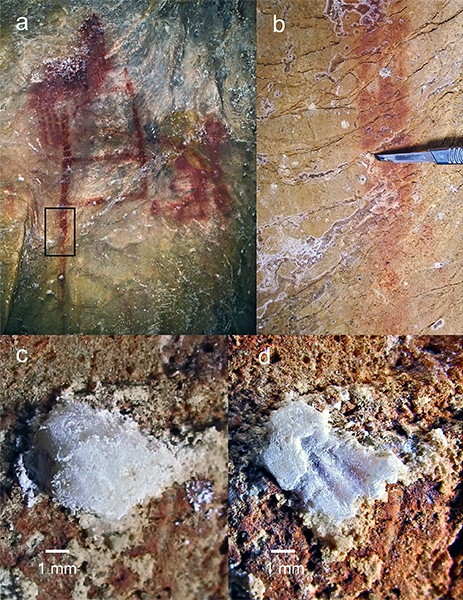
Sampling details for PAS 34.
(a) Scalariform motif; the black rectangle denotes the area enlarged in (b).
(b) The scalpel points onto the carbonate crust before sampling.
(c) The carbonate crust after the surface was scraped for initial cleaning.
(d) The carbonate crust after sampling, red pigment is visible in the centre, clearly underlying the remaining carbonate.
Photo and text: Hoffmann et al. (2018)
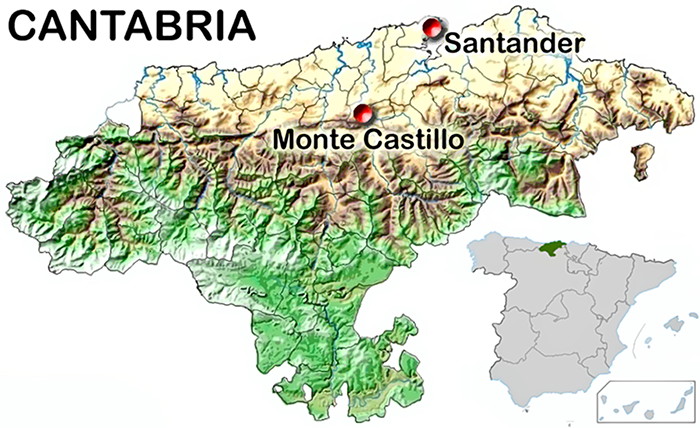
La Pasiega cave is one of the caves of Monte Castillo, the locality shown here, in northern Spain.
Photo: Hoffmann et al. (2018)
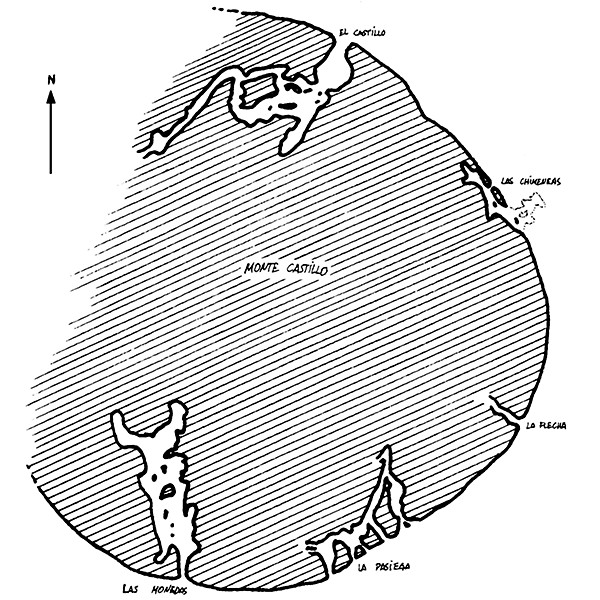
Map of the El Castillo complex of limestone caves in which Cueva de La Pasiega is located.
It contains the most convincing evidence for Neanderthal art.
Photo: Hoffmann et al. (2018)
Satellite photograph from Google Earth of the El Castillo site.
The view has been tilted to indicate the local relief, with the cave complex on the limestone hill of Monte Castillo.
Photo: Google Earth
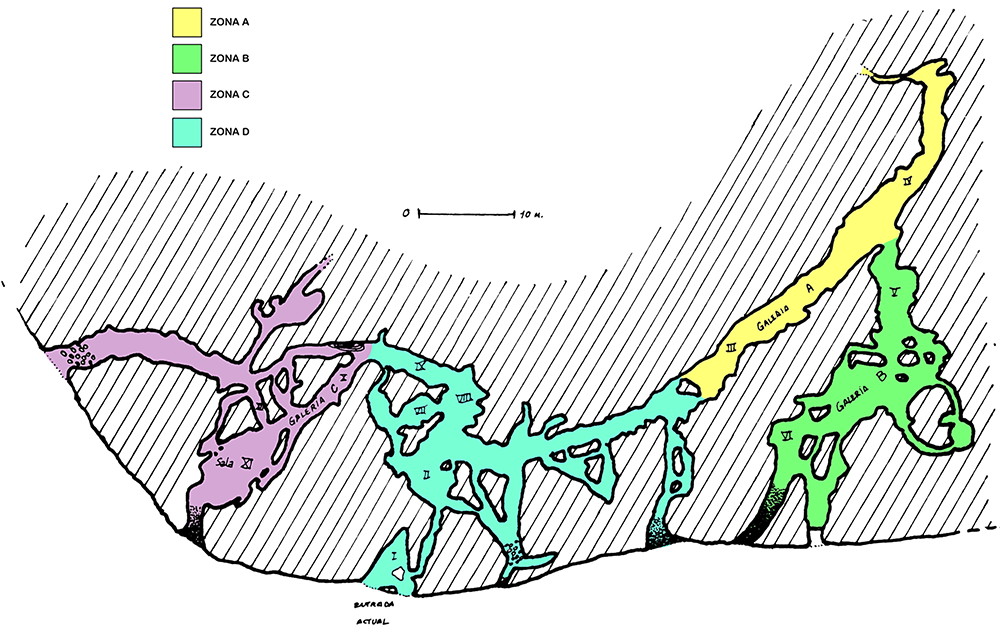
Plan of La Pasiega cave in Spain
Photo: José-Manuel Benito Álvarez —> Locutus Borg
Permission: GNU Free Documentation License, Version 1.2
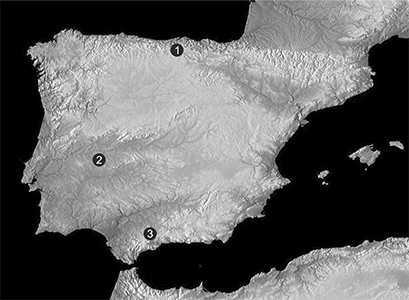
Map of the Iberian Peninsula. The dots indicate the locations of the three cave sites.
1: La Pasiega
2: Maltravieso
3: Ardales
Photo: Hoffmann et al. (2018)
Entrance to Maltravieso cave. Unusually, it is within the boundaries of a town, Cáceres.
Photo: http://www.turismoextremadura.com/
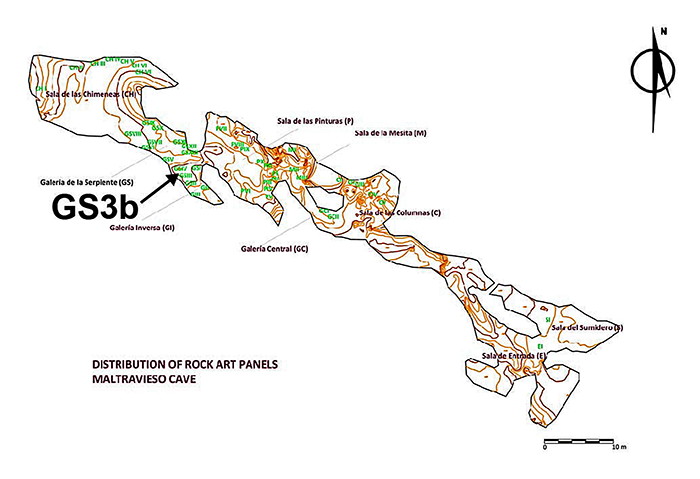
Map of Maltravieso cave. The painted panels are in green.
Hand stencil GS3b is located in the Galería de la Serpiente.
Photo: Hoffmann et al. (2018)
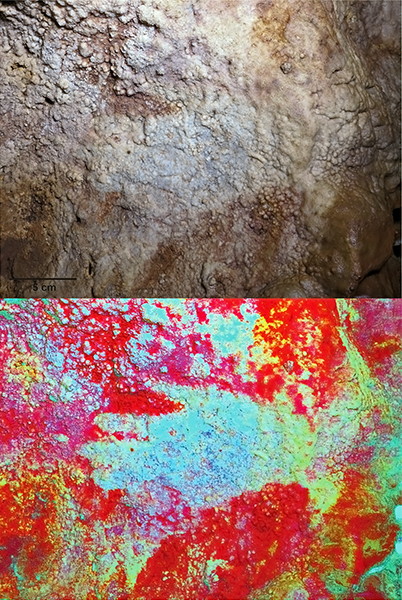
Hand stencil GS3b, Maltravieso cave, prior to sampling.
The upper picture shows the original photo, the lower is the same picture after application of DStretch, a false colour program which brings out images that are otherwise close to invisible.
Photo: Hoffmann et al. (2018)
This image shows the chamber inside Maltravieso cave where three stencils hands have been identified.
( note that because of the clarity of the hand stencils in the image above, they are most unlikely to include the one used to prove that it was done by a Neandertal, which is mostly covered by calcite, and almost invisible - Don )
Photo: https://arstechnica.com/
Hand stencil GS3b in Maltravieso cave (minimum age 66 700 BP).
(left) Original photo. The inset shows where the overlying carbonate was sampled
for MAL 13.
(right) Same picture after application of the DStretch software (25) (correlation LRE 15%, auto contrast) to enhance colour contrast.
Photo and text: Hoffmann et al. (2018)
Map of Ardales Cave.
Photo: Hoffmann et al. (2018)
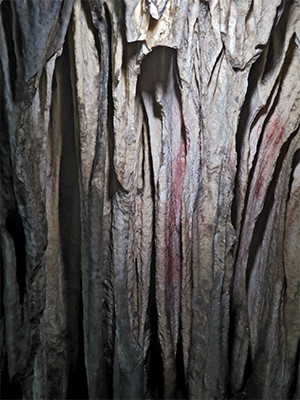
Curtain formation, Panel II-A-3, Ardales.
Red ochre (haematite?) can be seen on the curtains in the middle and on the right.
Photo: Hoffmann et al. (2018)
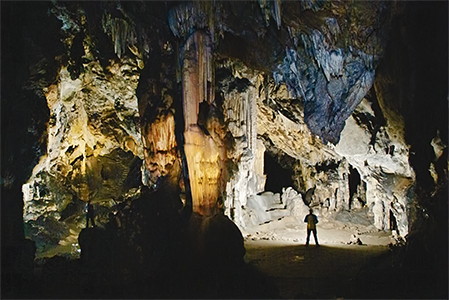
Interior of Ardales Cave.
The cave of Ardales, which is also known as Cueva de Doña Trinidad or the Calinoria, was discovered in 1821 after the great earthquake in Alhama de Granada, which left the access to the cave open, after sedimentation had kept it sealed for more than 8 000 years.
The underground complex situated in the extreme west of the Serrezuela, at about 550 and 600 metres altitude above sea level and with a geological age of around 2.5 million years, has not suffered any changes for the last 30 000 years. Its use as a tourist attraction was first initiated by Doña Trinidad Grund, a women from Seville and daughter of the Consul General, who arrived in Malaga at the age of 15 and who bought the cave in 1860. She had a staircase and supports for some torches fixed into the wall.
Photo: http://ventaelpunto.com/reservas/
Text: Adapted from http://www.malaga.es/en/turismo/naturaleza/cnl-86/lis_cd-1696/
On her death in 1896 the cave was abandoned, although in 1918 Henri Breuil conducted a detailed study of it. However, it was in 1985 when its recuperation and protection began. Nowadays, visitors can enjoy a one and a half kilometre walk through the inside to see such outstanding features as the Gran Sala, la Sala del Lago, la Galería del Espolón, la Galería de los Grabado and la Sala de las Manos.
A visit to the cave will reveal a labyrinth of columns, permanent lakes and beautiful stalactite and stalagmite formations. There are also some paintings and engravings dating from the Upper Palaeolithic period of about 20 000 years ago. The most important figure is the Gran Cierva en Negro or the Deer of Ardales. This is painted in black with a thick red tip where the heart is. There are other drawings of deer, goats, and fish. These relics, paintings, and engravings from the Palaeolithic period are done in 5 different colours, 8 distinct types of engravings with 4 different themes; abstract items, stains, traces, triangles, hands (about 10 and they are seemingly unique due to the way they are made) feminine figures and fauna ( there are more than 80 pictures of deer, horses, goats) make this cave almost unique in the whole world ( there are only 10 with similar characteristics). All this led to the cave being declared Patrimonio de la Humanidad (Patrimony of Humankind) in 1998.
Text above: Adapted from http://www.malaga.es/en/turismo/naturaleza/cnl-86/lis_cd-1696/
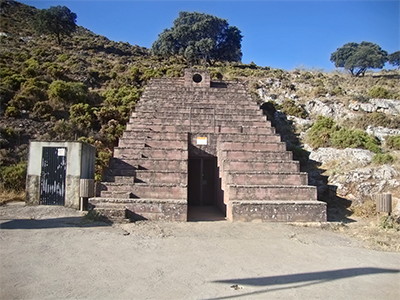
( The present entrance has been built so that visitors may hear a guide talk to them to give advice before entering the cave - Don )
Only 1000 people a year are allowed to visit this cave (and always with an official guide) and the visits must be in groups of a maximum of 15 people a day. Such visits must be previously arranged by ringing 952 458 046. Due to the type length of the tour, it is recommended that visitors wear comfortable rubber-soled shoes. The temperature inside the cavity is 17° C and the humidity level is stable between 90% and 100%.
Photo: http://www.malaga.es/en/turismo/naturaleza/cnl-86/lis_cd-1696/
Text: Adapted from http://www.malaga.es/en/turismo/naturaleza/cnl-86/lis_cd-1696/
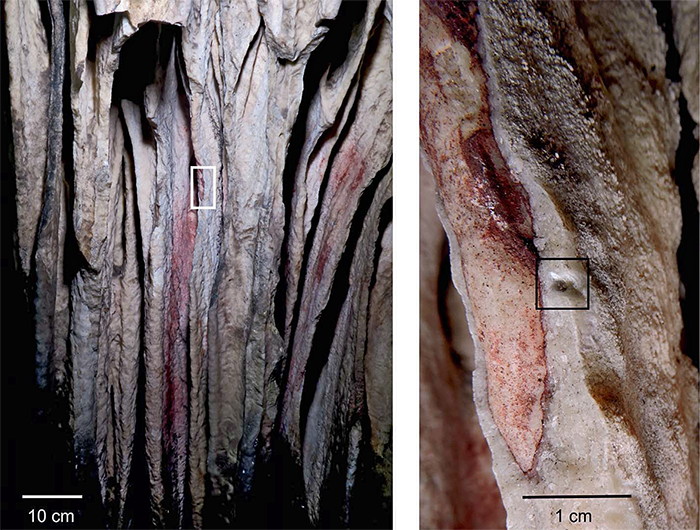
Speleothem curtain 8 in section II-A-3 in Ardales cave with red pigment, painted before at least 65 000 BP.
(left) Series of curtains with red paint on top, partially covered with later speleothem growth.The white rectangle outlines the area shown at right.
(right) Detail of curtain 8. The black square indicates where carbonate, overlying the red paint, was sampled for ARD 13.
Photo and text: Hoffmann et al. (2018)
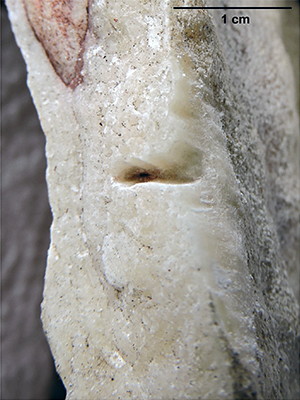
Detail of ARD 12 after sampling. Pigment is clearly visible towards the base of the sample area.
Photo and text: Hoffmann et al. (2018)
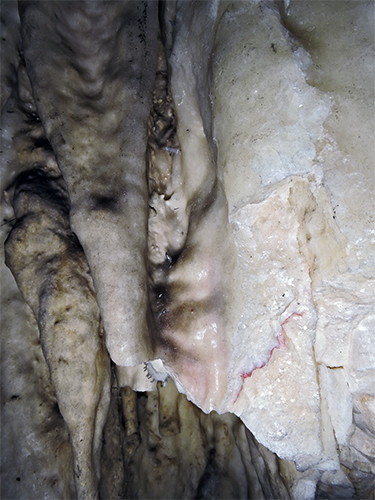
Broken curtain formation close to Panel III-C-2, Ardales.
Red paint applied on a surface now completely covered by subsequent speleothem growth can be seen in cross-section as a thin red line on the clean fracture surface.
Photo and text: Hoffmann et al. (2018)
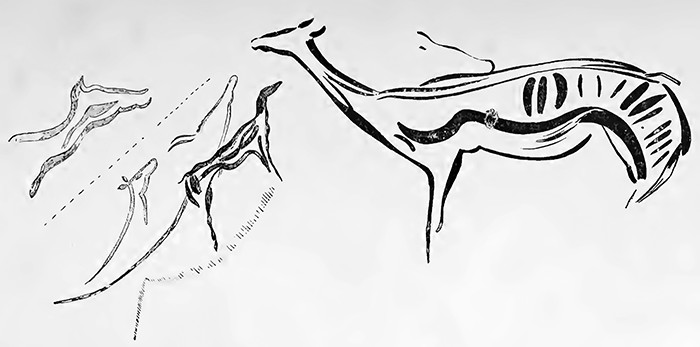
Ardales - Main painted panel. True width 120 cm. The colour yellow is indicated by vertical hatching. The red, longitudinal, brown, the same, but much denser. Note the red dot on the flank of the large black doe. The red head placed to the left in the corner is painted on the left wall, with the same scale.
Ardales - Principal panneau peint. Largeur vraie: 1m 20. La couleur jaune y est indiquée par des hachures verticales. La rouge, par des longitudinales, la brune comme celle-ci, mais bien plus dense. Noter le point roughe au flanc de la grande Biche noire. La tete rouge placée a gauche dans l'angle est peinte sur la paroi de gauche. Meme échelle.
Photo and text: Breuil (1921)
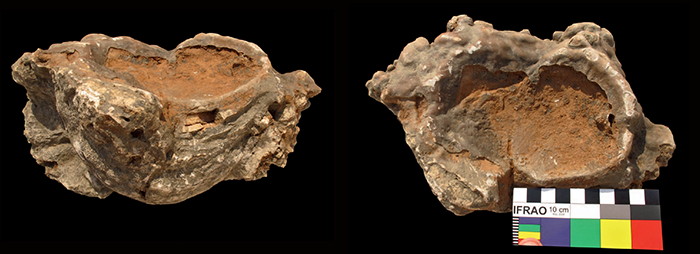
Top part of a stalagmite in Ardales that was broken off and used as a container for pigment.
Photo and text: Cantalejo et al. (2014)
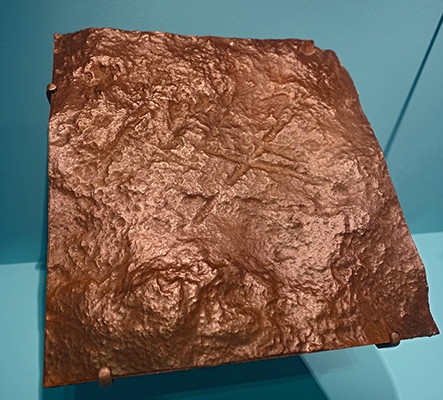
Facsimile of an engraving attributed to Neandertals, at Gorham's Cave, Gibraltar.
Photo: Don Hitchcock 2018
Source and text: Musée de l'Homme, Paris
References
- Alcalde del Rio H., Breuil H. & Sierra L., 1912: Les cavernes de la région cantabrique, Monaco, Vve A. Chêne, 265 p.
- Aubert M., Brumm, A., Taçon, P., 2017: The timing and nature of human colonization of Southeast Asia in the Late Pleistocene: a rock art perspective.CurrentAnthropology, 58, S553eS566.
- Aubert M., Brumm, A., Huntley J., 2018: Early dates for 'Neanderthal cave art' may be wrong, Journal of Human Evolution, xxx (2018) 1-3
- Breuil, H., Obermaier, H., Alcalde Del Rio, H., 1913: La Pasiega à Puente-Viesgo (Santander) (Espagne), Imprimerie Artistique Vve A. Chêne, 1913
- Breuil, H., 1921: Nouvelles cavernes ornées paleolithiques dans la province de Málaga, L'Anthropology, T. XXXI, no. 34. Paris.
- Cantalejo P., Ramos J., Weniger G., Kehl M., del Mar Espejo M., 2014: Cueva de Ardales, Province of Malaga, Southern Mediterranean Coast, Guadalquivir River and Betic Intramontane Basins, Pleistocene and Holocene Hunter-Gatherers in Iberia and the Gibraltar Strait: The Current Archaeological Record, Universidad de Burgos 2014
- Dickson M., 1915: The American Museum Journal, Volume XV, 1915, NYC.
- Hoffmann, D., et al., 2018: U-Th dating of carbonate crusts reveals Neandertal origin of Iberian cave art, Science, 359 (6378), 912-915. DOI: 10.1126/science.aap7778, pp. 912–915 (2018) 23 February 2018
- White, R., et al., 2019: Still no archaeological evidence that Neanderthals created Iberian cave art, Journal of Human Evolution, https://doi.org/10.1016/j.jhevol.2019.102640
Back to Don's Maps
 Back to Archaeological Sites
Back to Archaeological Sites
